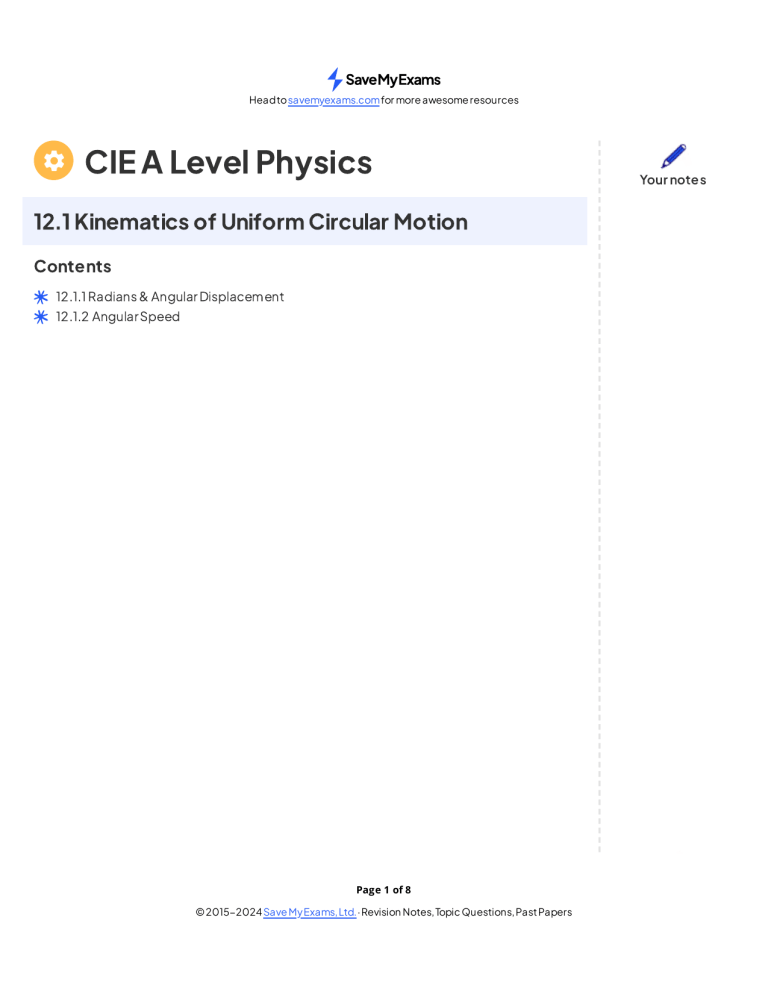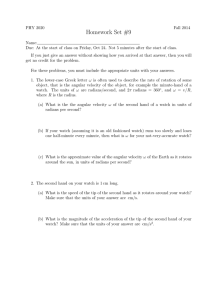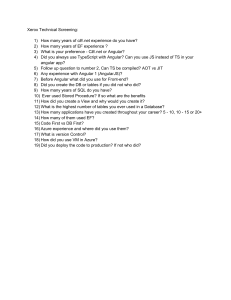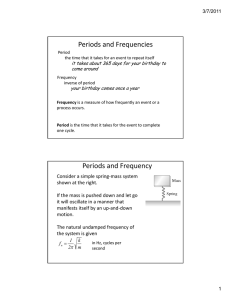
Head to savemyexams.com for more awesome resources CIE A Level Physics 12.1 Kinematics of Uniform Circular Motion Contents 12.1.1 Radians & Angular Displacement 12.1.2 Angular Speed Page 1 of 8 © 2015-2024 Save My Exams, Ltd. · Revision Notes, Topic Questions, Past Papers Your notes Head to savemyexams.com for more awesome resources 12.1.1 Radians & Angular Displacement Your notes Radians & Angular Displacement In circular motion, it is more convenient to measure angular displacement in units of radians rather than units of degrees The angular displacement (θ ) of a body in circular motion is defined as: The change in angle, in radians, of a body as it rotates around a circle The angular displacement is the ratio of: Note: both distances must be measured in the same units e.g. metres A radian (rad) is defined as: The angle subtended at the centre of a circle by an arc equal in length to the radius of the circle Angular displacement can be calculated using the equation: Page 2 of 8 © 2015-2024 Save My Exams, Ltd. · Revision Notes, Topic Questions, Past Papers Head to savemyexams.com for more awesome resources When the angle is equal to one radian, the length of the arc (Δs) is equal to the radius (r) of the circle Where: Δθ = angular displacement, or angle of rotation (radians) s = length of the arc, or the distance travelled around the circle (m) r = radius of the circle (m) Radians are commonly written in terms of π The angle in radians for a complete circle (360o ) is equal to: If an angle of 360o = 2π radians, then 1 radian in degrees is equal to: Use the following equation to convert from degrees to radians: Table of common degrees to radians conversions Page 3 of 8 © 2015-2024 Save My Exams, Ltd. · Revision Notes, Topic Questions, Past Papers Your notes Head to savemyexams.com for more awesome resources Worked example Convert the following angular displacement into degrees: Page 4 of 8 © 2015-2024 Save My Exams, Ltd. · Revision Notes, Topic Questions, Past Papers Your notes Head to savemyexams.com for more awesome resources Exam Tip You will notice your calculator has a degree (Deg) and radians (Rad) mode This is shown by the “D” or “R” highlighted at the top of the screen Remember to make sure it’s in the right mode when using trigonometric functions (sin, cos, tan) depending on whether the answer is required in degrees or radians It is extremely common for students to get the wrong answer (and lose marks) because their calculator is in the wrong mode - make sure this doesn’t happen to you! Page 5 of 8 © 2015-2024 Save My Exams, Ltd. · Revision Notes, Topic Questions, Past Papers Your notes Head to savemyexams.com for more awesome resources 12.1.2 Angular Speed Your notes Angular Speed Any object travelling in a uniform circular motion at the same speed travels with a constantly changing velocity This is because it is constantly changing direction, and is therefore accelerating The angular speed (⍵) of a body in circular motion is defined as: The rate of change in angular displacement with respect to time Angular speed is a scalar quantity, and is measured in rad s -1 When an object is in uniform circular motion, velocity constantly changes direction, but the speed stays the same Page 6 of 8 © 2015-2024 Save My Exams, Ltd. · Revision Notes, Topic Questions, Past Papers Head to savemyexams.com for more awesome resources Calculating Angular Speed Taking the angular displacement of a complete cycle as 2π, the angular speed ⍵ can be calculated using the equation: Where: Δθ = change in angular displacement (radians ) Δt = time interval (s) T = the time period (s) f = frequency (Hz ) Angular velocity is the same as angular speed, but it is a vector quantity When an object travels at constant linear speed v in a circle of radius r, the angular velocity is equal to: Where: v is the linear speed (m s -1) r is the radius of orbit (m) This equation tells us: The greater the rotation angle θ in a given amount of time, the greater the angular velocity ⍵ An object rotating further from the centre of the circle (larger r) moves with a smaller angular velocity (smaller ⍵) Worked example A bird flies in a horiz ontal circle with an angular speed of 5.25 rad s -1 of radius 650 m.Calculate: a) The linear speed of the bird b) The frequency of the bird flying in a complete circle Page 7 of 8 © 2015-2024 Save My Exams, Ltd. · Revision Notes, Topic Questions, Past Papers Your notes Head to savemyexams.com for more awesome resources Your notes Page 8 of 8 © 2015-2024 Save My Exams, Ltd. · Revision Notes, Topic Questions, Past Papers

![[MATH2019] Final exam notes](http://s3.studylib.net/store/data/025296565_1-0d5b41f3ef39ac8ec6df0bd44c901026-300x300.png)



